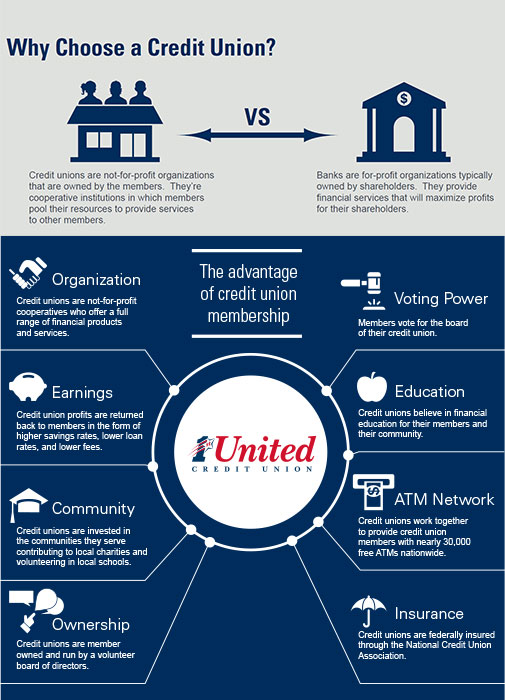The Ultimate Guide to Comprehending Cooperative Credit Union

Credit unions stand as one-of-a-kind monetary entities, rooted in principles of common support and member-driven procedures. Nonetheless, beyond their fundamental worths, comprehending the complex functions of lending institution entails a much deeper exploration. Deciphering the intricacies of membership eligibility, the evolution of solutions offered, and the distinct benefits they bring requires a thorough assessment. As we browse through the complexities of lending institution, an informative trip waits for to shed light on these member-focused establishments and how they differ from traditional banks.
What Are Cooperative Credit Union?
Credit score unions are member-owned financial organizations that supply an array of financial solutions to their participants. Unlike conventional banks, lending institution run as not-for-profit companies, suggesting their primary focus is on offering their members as opposed to optimizing earnings. Participants of a lending institution normally share an usual bond, such as benefiting the same employer, belonging to the exact same community, or belonging to the exact same company.
One of the crucial benefits of cooperative credit union is that they typically supply greater passion prices on interest-bearing accounts and reduced rate of interest on fundings compared to banks. Hybrid Line of Credit. This is due to the fact that cooperative credit union are structured to benefit their participants straight, permitting them to pass on their incomes in the type of much better prices and less fees. Furthermore, credit history unions are recognized for their customized customer service, as they prioritize building partnerships with their members to comprehend their distinct monetary requirements and objectives
History and Development of Lending Institution
The roots of member-owned monetary cooperatives, known today as cooperative credit union, trace back to a time when areas looked for choices to conventional banking institutions. The concept of credit score unions stem in the 19th century in Europe, with Friedrich Wilhelm Raiffeisen frequently credited as the leader of the participating financial activity. Raiffeisen founded the initial identified cooperative credit union in Germany in the mid-1800s, highlighting neighborhood support and self-help principles.
The evolution of lending institution proceeded in The United States and copyright, where Alphonse Desjardins established the very first lending institution in copyright in 1900. Soon after, in 1909, the initial U.S. cooperative credit union was created in New Hampshire by a group of Franco-American immigrants. These very early credit score unions operated on the fundamental concepts of shared help, autonomous control, and member possession.
In time, cooperative credit union have expanded in appeal worldwide as a result of their not-for-profit structure, concentrate on offering members, and using competitive monetary product or services. Today, credit unions play a crucial role in the monetary sector, offering community-oriented and easily accessible banking options for people and businesses alike.
:max_bytes(150000):strip_icc()/dotdash-credit-unions-vs-banks-4590218-v2-70e5fa7049df4b8992ea4e0513e671ff.jpg)
Membership and Eligibility Requirements
Membership at a credit history union is typically restricted to individuals satisfying particular eligibility criteria based on the institution's founding principles and regulatory needs. Some credit report unions might only serve individuals who function or live in a certain area, while others may be customized to employees of a certain firm or members of a particular organization.
Additionally, lending institution are structured as not-for-profit organizations, implying that their key objective is to serve their members as opposed to produce earnings for shareholders. This emphasis on member solution commonly translates right into even Federal Credit Union more customized attention, lower fees, and competitive rate of interest on financial savings and financings accounts. By meeting the qualification requirements and coming to be a member of a lending institution, individuals can access a series of financial products and solutions customized to their certain requirements.
Providers and Products Supplied
One of the vital aspects that sets debt unions apart is the varied array of economic services and products they offer to their participants. Credit history unions commonly give traditional financial solutions such as savings and examining accounts, fundings, and credit score cards.
In addition, cooperative credit union frequently provide hassle-free online and mobile banking options for participants to conveniently handle their financial resources. They may provide benefits such as shared branching, permitting participants to access their accounts at other credit report unions across the country. Some lending institution also supply insurance items like auto, life, and home insurance coverage to help participants shield their assets and loved ones.

Benefits of Financial With Credit Unions
When considering banks, exploring the benefits of banking with cooperative credit union discloses special benefits for members looking for individualized solution and competitive prices. One significant benefit of credit report unions is their concentrate on customized consumer service. Unlike big banks, lending institution are member-owned and prioritize building strong relationships with their members. This suggests that cooperative credit union personnel typically have look at these guys a much deeper understanding of their participants' financial needs and can use customized solutions Look At This to assist them accomplish their objectives. Additionally, debt unions are known for using competitive rates of interest on financial savings and lendings accounts. Since they are not-for-profit organizations, credit report unions can typically provide lower lending rates, greater cost savings prices, and lower costs contrasted to typical banks. This can lead to substantial cost savings for participants in time. On the whole, financial with a credit rating union can give a much more individualized, cost-efficient, and member-centric economic experience.
Final Thought
In final thought, credit score unions stand out as member-owned economic institutions that prioritize serving their members over optimizing profits. With origins dating back to 19th century Europe, debt unions comply with concepts of common support and participant ownership.
Credit score unions are member-owned monetary organizations that offer an array of financial services to their participants. The idea of credit history unions stem in the 19th century in Europe, with Friedrich Wilhelm Raiffeisen usually attributed as the pioneer of the participating financial movement.The advancement of credit score unions proceeded in North America, where Alphonse Desjardins established the very first credit history union in copyright in 1900. Debt unions typically give typical financial services such as savings and checking accounts, car loans, and debt cards.When considering financial institutions, exploring the benefits of financial with credit scores unions reveals unique advantages for members seeking customized solution and competitive prices.
 Josh Saviano Then & Now!
Josh Saviano Then & Now! Christina Ricci Then & Now!
Christina Ricci Then & Now! Nancy Kerrigan Then & Now!
Nancy Kerrigan Then & Now! Bo Derek Then & Now!
Bo Derek Then & Now! Lacey Chabert Then & Now!
Lacey Chabert Then & Now!